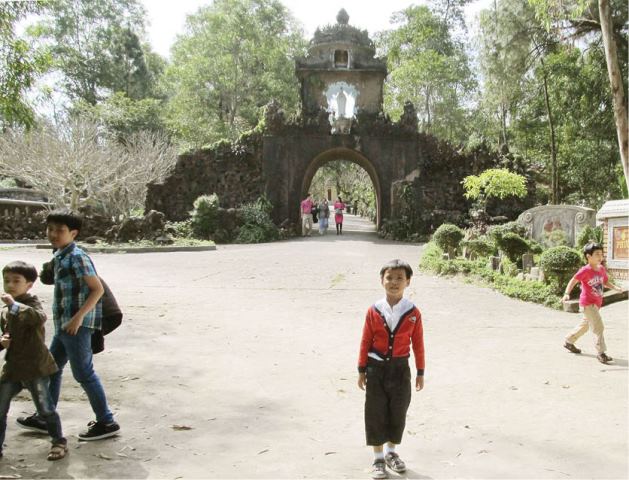
Quan The Am Cave - The main gate leading to the pagoda built in 1966
I was excited because I could meet my aunt and visit the old jackfruit forest in the pagoda's garden. If I was lucky, the visit would fall during the jackfruit season and I would have the good fortune of several sweet and fragrant jackfruit segments.
I was also excited because I could admire the "old Mister pig” with curved fangs pointing to the two sides, his body as big as the H-shaped table. Despite such an intimidating appearance, the "old Mister pig” was very gentle and friendly.
However, I despised the walk. At that time, there were only two ways from the city center to Dieu Vien Pagoda. The main way was to follow Highway 1A, go past the current position of Thuy Duong overpass for a distance, then turn right and continue to the end of the winding road to reach the pagoda.
The shortcut was to go to the Bac tren sewer, cross the railway to Giong hamlet, then zigzag passing the cemetery, and cut through the village to enter the pagoda. This is the path that my grandmother often chose because it was closer and within walking distance. But for me at that time, a round trip back and forth was a torture.
At that time, Dieu Vien was literally deep in the mountain. Now, it's different. Village roads have been widened and upgraded. Graves were relocated to make space for residential areas. Another road, Thuy Duong - Tu Duc (now known as Vo Van Kiet road) was built. Dieu Vien Pagoda was once deep in the mountain has now become a pagoda on the street front. From the center of Hue city, it takes about ten minutes to get there.
In 1924, the pagoda was built on a hill in Thuy Duong commune (Huong Thuy town) by some lay Buddhists. They then invited Nun Thich Nu Huong Dao to lead the nunnery. This is the first nunnery in Hue. In 1926, the Emperor of the Nguyen Dynasty granted the title “Sac tu Dieu Vien Su Nu Tu”. After the initial construction date, the pagoda was also restored and expanded in 1929, 1953 and 2001.
Despite being situated deep in the mountain, with the virtue, talent and enthusiasm for the Dharma of the abbess and nuns in the pagoda, Dieu Vien quickly became a spacious and meditative pagoda and known by many.
Especially with the special talent in household arts, the nuns in the pagoda have successfully opened a workshop to produce incense, soy sauces, soya cheese, cakes of all kinds and have been trusted and supported by the Buddhist community.
In addition, the pagoda has also opened a clinic that provides free medical examination and medicine for the poor; and opened a nursing home to provide lonely and disabled elderly people a place to live and to take care of them in their final days. The pagoda also established a sewing facility to create jobs for young local women, and opened free schools and kindergartens …
After a period of hiatus due to lack of funding, now the nursing home, acupuncture treatment, kindergarten ... have restored their operation, bringing practical help to the masses and Buddhists.
The pagoda has also been restored not long ago. The new roads have contributed to making the pagoda more solemn and radiant. All it takes is a quick drive and you can worship and admire the scenery at Dieu Vien Pagoda - the first Buddhist nunnery in Hue. So, what are you waiting for?
Story and photo: HUY KHANH
